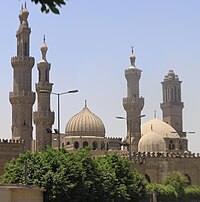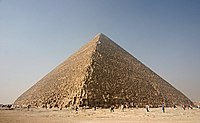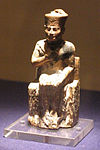Selected article 1
Portal:Egypt/Selected article/1
Al-Azhar Mosque (Arabic: الجامع الأزهر, romanized: al-Jāmiʿ al-ʾAzhar, "The Most Resplendent Congregational Mosque"), also simply in Egypt Al-Azhar (Arabic: الأزهر), is an Egyptian mosque in Islamic Cairo. Al-Mu'izz li-Din Allah of the Fatimid dynasty commissioned its construction for the newly established capital city in 970. Its name is usually thought to allude to the Islamic prophet Muhammad's daughter Fatimah, a revered figure in Islam who was given the title az-Zahrāʾ ("the shining or resplendent one"). It was the first mosque established in Cairo, a city that has since gained the nickname "the City of a Thousand Minarets". After its dedication in 972, and with the hiring by mosque authorities of 35 scholars in 989, the mosque slowly developed into what is today the second oldest continuously run university in the world after Al Karaouine in Idrisid Fes. Al-Azhar University has long been regarded as the foremost institution in the Islamic world for the study of Sunni theology and sharia, or Islamic law. The university, integrated within the mosque as part of a mosque school since its inception, was nationalized and officially designated an independent university in 1961, following the Egyptian Revolution of 1952.
Over the course of its over a millennium-long history, the mosque has been alternately neglected and highly regarded. Because it was founded as a Shiite Ismaili institution, Saladin and the Sunni Ayyubid dynasty that he founded shunned al-Azhar, removing its status as a congregational mosque and denying stipends to students and teachers at its school. These moves were reversed under the Mamluk Sultanate, under whose rule numerous expansions and renovations took place. Later rulers of Egypt showed differing degrees of deference to the mosque and provided widely varying levels of financial assistance, both to the school and to the upkeep of the mosque. Today, al-Azhar remains a deeply influential institution in Egyptian society that is highly revered in the Sunni Muslim world and a symbol of Islamic Egypt.
Selected article 2
Portal:Egypt/Selected article/2
The Battle of the Nile was a significant naval action fought during 1–3 August 1798. The battle took place in Aboukir Bay, near the mouth of the River Nile on the Mediterranean coast of Egypt and pitted a British fleet of the Royal Navy against a fleet of the French Navy. The battle was the climax of a three-month campaign in the Mediterranean during which a huge French convoy under General Napoleon Bonaparte had sailed from Toulon to Alexandria via Malta. Despite close pursuit by a British fleet of thirteen ships of the line, one fourth rate and a sloop under Sir Horatio Nelson, the French were able to reach Alexandria unscathed and successfully land an army, which Bonaparte led inland. The fleet that had escorted the convoy, consisting of thirteen ships of the line, four frigates and a number of smaller vessels under Vice-Admiral François-Paul Brueys D'Aigalliers, anchored in Aboukir Bay as Alexandria harbour was too narrow, forming a line of battle that was protected by shoals to the north and west.
The almost total destruction of the French fleet reversed the strategic situation in the Mediterranean, giving the Royal Navy control of the sea which it retained until the end of the Napoleonic Wars in 1815. Nelson and his captains were highly praised and generously rewarded, although Nelson privately complained that his peerage was not senior enough. Bonaparte's army was trapped in the Middle East and Royal Navy dominance played a significant part in its subsequent defeat at the Siege of Acre, Bonaparte himself abandoned the army late in 1799 to return to France and deal with the outbreak of the War of the Second Coalition. Of the captured ships, three were no longer serviceable and were burnt in the bay, and three others were judged fit only for harbour duties owing to the damage they had received in the battle. The remainder enjoyed long and successful service careers in the Royal Navy; two subsequently served at the Battle of Trafalgar in 1805.
Selected article 3
Portal:Egypt/Selected article/3
The Great Pyramid of Giza (also known as the Pyramid of Khufu or the Pyramid of Cheops) is the oldest and largest of the three pyramids in the Giza pyramid complex bordering present-day El Giza, Egypt. It is the oldest of the Seven Wonders of the Ancient World, and the only one to remain largely intact.
Based on a mark in an interior chamber naming the work gang and a reference to the fourth dynasty Egyptian Pharaoh Khufu, some Egyptologists believe that the pyramid was thus built as a tomb over a 10- to 20-year period concluding around 2560 BC. Initially at 146.5 metres (481 feet), the Great Pyramid was the tallest man-made structure in the world for more than 3,800 years until Lincoln Cathedral was finished in 1311 AD. Originally, the Great Pyramid was covered by limestone casing stones that formed a smooth outer surface; what is seen today is the underlying core structure. Some of the casing stones that once covered the structure can still be seen around the base. There have been varying scientific and alternative theories about the Great Pyramid's construction techniques. Most accepted construction hypotheses are based on the idea that it was built by moving huge stones from a quarry and dragging and lifting them into place.
There are three known chambers inside the Great Pyramid. The lowest chamber is cut into the bedrock upon which the pyramid was built and was unfinished. The so-called Queen's Chamber and King's Chamber are higher up within the pyramid structure. The main part of the Giza complex is a set of buildings that included two mortuary temples in honour of Khufu (one close to the pyramid and one near the Nile), three smaller pyramids for Khufu's wives, an even smaller "satellite" pyramid, a raised causeway connecting the two temples, and small mastaba tombs surrounding the pyramid for nobles.
Selected article 4
Portal:Egypt/Selected article/4
Khufu (/ˈkuːfuː/, full name Khnum Khufu (/ˈknuːmˈkuːfuː/), known to the Greeks as Cheops, was an ancient Egyptian monarch who was the second pharaoh of the Fourth Dynasty, in the first half of the Old Kingdom period (26th century BC). Khufu succeeded his father Sneferu as king. He is generally accepted as having commissioned the Great Pyramid of Giza, one of the Seven Wonders of the Ancient World, but many other aspects of his reign are poorly documented.
The only completely preserved portrait of the king is a three-inch high ivory figurine found in a temple ruin of a later period at Abydos in 1903. All other reliefs and statues were found in fragments, and many buildings of Khufu are lost. Everything known about Khufu comes from inscriptions in his necropolis at Giza and later documents. For example, Khufu is the main character noted in the Westcar Papyrus from the 13th dynasty.
Most documents that mention king Khufu were written by ancient Egyptian and Greek historians around 300 BC. Khufu's obituary is presented there in a conflicting way: while the king enjoyed a long-lasting cultural heritage preservation during the period of the Old Kingdom and the New Kingdom, the ancient historians Manetho, Diodorus and Herodotus hand down a very negative depiction of Khufu's character. Thanks to these documents, an obscure and critical picture of Khufu's personality persists.
Selected article 5
Portal:Egypt/Selected article/5
The Kingdom of Egypt (Arabic: المملكة المصرية Al-Mamlaka Al-Miṣreyya, "the Egyptian Kingdom") was the de jure independent Egyptian state established under the Muhammad Ali Dynasty in 1922 following the Unilateral Declaration of Egyptian Independence by the United Kingdom. Until the Anglo-Egyptian treaty of 1936, the Kingdom was only nominally independent, since the British retained control of foreign relations, communications, the military and the Anglo-Egyptian Sudan. Between 1936 and 1952, the British continued to maintain military presence and political advisers, at a reduced level.
The legal status of Egypt had been highly convoluted, due to its de facto breakaway from the Ottoman Empire in 1805, its occupation by Britain in 1882, and its transformation into a sultanate and British protectorate in 1914. In line with the change in status from sultanate to kingdom, the Sultan of Egypt, Fuad I, saw his title changed to King.
The kingdom's sovereignty was subject to severe limitations imposed by the British, who retained enormous control over Egyptian affairs, and whose military continued to occupy the country. Throughout the kingdom's existence Sudan was formally united with Egypt. However, actual Egyptian authority in Sudan was largely nominal due to Britain's role as the dominant power in Anglo-Egyptian Sudan.
During the reign of King Fuad, the monarchy struggled with the Wafd Party, a broadly based nationalist political organization strongly opposed to British domination, and with the British themselves, who were determined to maintain control over the Suez Canal. Other political forces emerging in this period included the Communist Party (1925), and the Muslim Brotherhood (1928), which eventually became a potent political and religious force.
King Fuad died in 1936 and Farouk inherited the throne at the age of sixteen. Alarmed by Italy's recent invasion of Abyssinia, he signed the Anglo-Egyptian Treaty, requiring Britain to withdraw all troops from Egypt, except in the Suez Canal Zone (agreed to be evacuated by 1949).
The kingdom was plagued by corruption, and its citizens saw it as a puppet of the British. This, coupled with the defeat in the 1948–1949 Palestine War, led to the Egyptian Revolution of 1952 by the Free Officers Movement. Farouk abdicated in favour of his infant son Fuad II. In 1953 the monarchy was formally abolished and the Republic of Egypt was established. The legal status of Sudan was only resolved in 1954, when Egypt and Britain agreed that it should be granted independence in 1956.
Selected article 6
Portal:Egypt/Selected article/6
Saint Virgin Mary's Coptic Orthodox Church (Coptic: ϯⲉⲕⲕⲗⲏⲥⲓⲁ ⲛ̀ⲧⲉⲑⲉⲟⲇⲟⲕⲟⲥ ϯⲁⲅⲓⲁ ⲙⲁⲣⲓⲁ Ϧⲉⲛ ⲃⲁⲃⲩⲗⲟⲛ ⲛ̀ⲭⲏⲙⲓ The Church of Mother of God Saint Mary in Egyptian Babylon) also known as The Hanging Church (Egyptian Arabic: الكنيسة المعلقة el Muʿallaqah, Coptic: ϯⲉⲕⲕⲗⲏⲥⲓⲁ ⲉϥⲓϣⲓ) is one of the oldest churches in Egypt and the history of a church on this site dates to the third century. It belongs to the Coptic Orthodox Church of Alexandria.
The Hanging Church is named for its location above a gatehouse of Babylon Fortress, the Roman fortress in Coptic Cairo (Old Cairo); its nave is suspended over a passage. The church is approached by twenty-nine steps; early travelers to Cairo dubbed it "the Staircase Church. The land surface has risen by some six metres since the Roman period, so the Roman tower is mostly buried below ground, reducing the visual impact of the church's elevated position. The entrance from the street is through iron gates under a pointed stone arch. The nineteenth-century facade with twin bell towers is then seen beyond a narrow courtyard decorated with modern art biblical designs. Up the steps and through the entrance is a further small courtyard leading to the eleventh-century outer porch.
Selected article 7
Portal:Egypt/Selected article/7
Al-Azhar University (/ˈɑːzhɑːr/ AHZ-har; Arabic: جامعة الأزهر (الشريف), IPA: [ˈɡæmʕet elˈʔɑzhɑɾ eʃʃæˈɾiːf], "the (honorable) University of Al-Azhar") is a university in Cairo, Egypt. Associated with Al-Azhar Mosque in Islamic Cairo, it is Egypt's oldest degree-granting university and is renowned as "Sunni Islam’s most prestigious university". In addition to higher education, Al-Azhar oversees a national network of schools with approximately two million students. As of 1996, over 4000 teaching institutes in Egypt were affiliated with the University.
Founded in 970 or 972 by the Fatimids as a centre of Islamic learning, its students studied the Qur'an and Islamic law in detail, along with logic, grammar, rhetoric, and how to calculate the phases of the moon. It was one of the first universities in the world, and the only one in the Arabic world to survive as a modern university including secular subjects in the curriculum. Today it is the chief centre of Arabic literature and Islamic learning in the world.
Its mission is to propagate Islam and Islamic culture. To this end, its Islamic scholars (ulamas) render edicts (fatwas) on disputes submitted to them from all over the Sunni Islamic world regarding proper conduct for Muslim individuals and societies. Al-Azhar also trains Egyptian government-appointed preachers in proselytization (da'wa).
Its library is considered second in importance in Egypt only to the Egyptian National Library and Archives. In May 2005, Al-Azhar in partnership with a Dubai information technology enterprise, IT Education Project (ITEP) launched the H.H. Mohammed bin Rashid Al Maktoum Project to Preserve Al Azhar Scripts and Publish Them Online (the "Al-Azhar Online Project") to eventually publish online access to the library's entire rare manuscripts collection, comprising about seven million pages of material.
Selected article 8
Portal:Egypt/Selected article/8
Cairo (/ˈkaɪroʊ/ KY-roh; Arabic: القاهرة, romanized: al-Qāhirah, pronounced [ælˈqɑːhɪɾɑ] ; Coptic: ⲕⲁϣⲣⲱⲙⲓ, romanized: Kashromi) is the capital of Egypt. The city's metropolitan area is one of the largest in Africa and the 15th-largest in the world, and is associated with ancient Egypt, as the famous Giza pyramid complex and the ancient city of Memphis are located in its geographical area. Located near the Nile Delta, modern Cairo was founded in 969 AD by the Fatimid dynasty, but the land composing the present-day city was the site of ancient national capitals whose remnants remain visible in parts of Old Cairo. Cairo has long been a centre of the region's political and cultural life, and is titled "the city of a thousand minarets" for its preponderance of Islamic architecture. Cairo is considered a World City with a "Beta +" classification according to GaWC.
Cairo has the oldest and largest film and music industries in the Middle East, as well as the world's second-oldest institution of higher learning, Al-Azhar University. Many international media, businesses, and organizations have regional headquarters in the city; the Arab League has had its headquarters in Cairo for most of its existence.
With a population of over 9 million. Adjusted census result, as Helwan governorate was created on 17 April 2008 from a.o. parts of the Cairo governorate.</ref> spread over 3,085 square kilometers (1,191 sq mi), Cairo is by far the largest city in Egypt. An additional 9.5 million inhabitants live in close proximity to the city. Cairo, like many other megacities, suffers from high levels of pollution and traffic. Cairo's metro, one of two in Africa (the other being in Algiers, Algeria), ranks among the fifteen busiest in the world, with over 1 billion annual passenger rides. The economy of Cairo was ranked first in the Middle East in 2005, and 43rd globally on Foreign Policy's 2010 Global Cities Index.
Selected article 9
Portal:Egypt/Selected article/9
Muizz Street (Egyptian Arabic: شارع المعز Shareʻ El Muizz, full name; Shariʻa al-Muizz li-Din Illah), in Islamic Cairo, Egypt is one of the oldest streets in Cairo, approximately one kilometer long. A United Nations study found it to have the greatest concentration of medieval architectural treasures in the Islamic world. The street (shariʻa in Arabic) is named for Al-Mu'izz li-Din Allah, the fourth caliph of the Fatimid dynasty. It stretches from Bab Al-Futuh in the north to Bab Zuweila in the south. Starting in 1997, the national government carried out extensive renovations to the historical buildings, modern buildings, paving, and sewerage to turn the street into an "open-air museum". On April 24, 2008, Al-Muizz Street was rededicated as a pedestrian only zone between 8:00 am and 11:00 pm; cargo traffic will be allowed outside of these hours.
The northern part of the street extends from the Al-Hakim Mosque in the north to the Spice Market at Al-Azhar Street and includes the antiques markets section, Al-Aqmar Mosque (one of the few extant Fatimid mosques), the Qalawun complex, and several well preserved medieval mansions and palaces. The southern part extends from the Ghuriya complex to the Bab Zuweila and includes the magnificent Tent Market in the Gamaliya district.
Selected article 10
Portal:Egypt/Selected article/10
Alexandria (/ˌælɪɡˈzændriə/ or /-ˈzɑːnd-/; Arabic: الإسكندرية al-ʾIskandariyya; Coptic: ⲁⲗⲉⲝⲁⲛⲇⲣⲓⲁ Alexandria or ⲣⲁⲕⲟϯ Rakote) is the second-largest city in Egypt and a major economic centre, extending about 32 km (20 mi) along the coast of the Mediterranean Sea in the north central part of the country. Its low elevation on the Nile delta makes it highly vulnerable to rising sea levels. Alexandria is an important industrial center because of its natural gas and oil pipelines from Suez. Alexandria is also a popular tourist destination.
Alexandria was founded around a small, ancient Egyptian town c. 332 BC by Alexander the Great, king of Macedon and leader of the Greek League of Corinth, during his conquest of the Achaemenid Empire. Alexandria became an important center of Hellenistic civilization and remained the capital of Ptolemaic Egypt and Roman and Byzantine Egypt for almost 1,000 years, until the Muslim conquest of Egypt in AD 641, when a new capital was founded at Fustat (later absorbed into Cairo). Hellenistic Alexandria was best known for the Lighthouse of Alexandria (Pharos), one of the Seven Wonders of the Ancient World; its Great Library (the largest in the ancient world); and the Necropolis, one of the Seven Wonders of the Middle Ages. Alexandria was at one time the second most powerful city of the ancient Mediterranean region, after Rome. Ongoing maritime archaeology in the harbor of Alexandria, which began in 1994, is revealing details of Alexandria both before the arrival of Alexander, when a city named Rhacotis existed there, and during the Ptolemaic dynasty.
From the late 18th century, Alexandria became a major center of the international shipping industry and one of the most important trading centers in the world, both because it profited from the easy overland connection between the Mediterranean Sea and the Red Sea, and the lucrative trade in Egyptian cotton.









